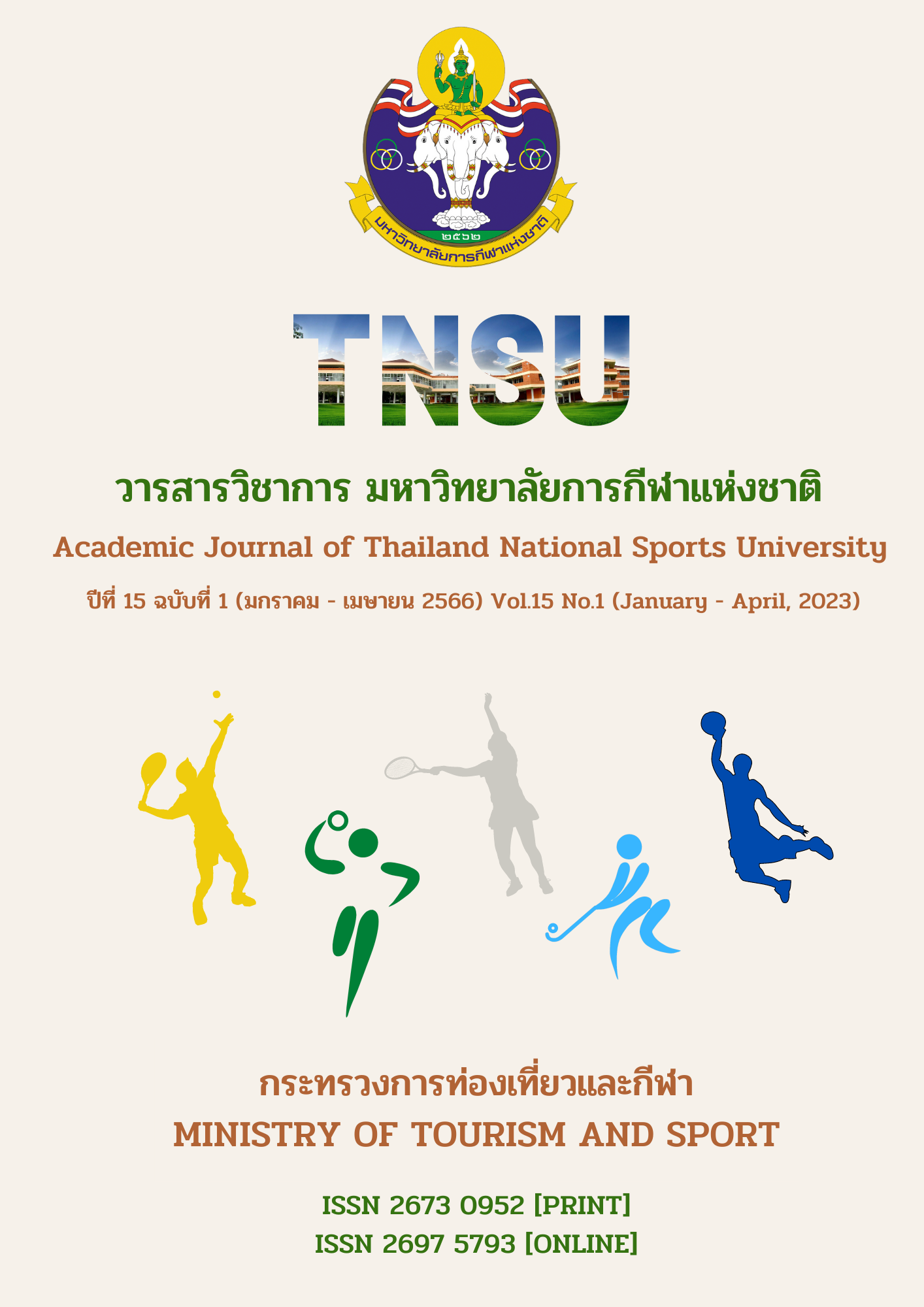THE RESULTS OF INTERVAL TRAINING AND CONTINUOUS TRAINING PROGRAMS TOWARDS MAXIMAL OXYGEN CONSUMPTION RATES OF FOOTBALL PLAYERS
Main Article Content
Abstract
This research aims to investigate and compare between the results of interval training and continuous training programs, as well as the differences of training times between interval training and continuous training programs towards maximal oxygen consumption rates of football players. The samples were forty - five male football players aged between 14 - 16 years old selected by purposive random sampling. They were divided into three groups by random assignment: Group 1 with the conventional training program only; Group 2 with the conventional program with the interval training program; and Group 3 with the conventional program with the continuous training program. All of them were trained three days a week for eight weeks and were tested to figure out the maximal oxygen consumption rates during the pre - training, after the fourth and the eighth weeks of training. Data analysis with mean, standard deviation, One - Way Analysis of Variance with repeated measure, and the Least Significant Difference method (LSD).
The findings revealed as follows:
Mean and Standard Deviation of maximal oxygen consumption rates before training of all three groups at before training, after training at Week 4 and after training at Week 8 showed that Group 1 (2.56 ± 0.11, 2.56± 0.11, 2.57 ± 0.08) consumed less than Group 2 (2.56 ± 0.11, 3.00± 0.09, 3.46 ± 0.11) and Group 3 (2.56 ± 0.07, 2.59 ± 0.07, 2.79 ± 0.10) respectively, and Group 3 most consumed.
Between groups, after the fourth - week significant differences in maximal oxygen consumption rate were found between Group 1 and Group 2, and between Group 2 and Group 3; moreover, after the eighth week, significant differences were found between Group 1 and Group 2 & Group 3, and between Group 2 and Group 3 at the level of .05.
Within groups, in Group 1 no significant differences in maximal oxygen consumption rates were found between pre - training, after the fourth and the eighth weeks while in Group 2 significant differences were found between pre – training and the fourth and the eighth weeks, and between the fourth week and the eighth week at the level of .05, and in Group 3 significant differences were found between pre - training and the fourth and the eighth weeks, and between the fourth week and the eighth week at the level of .05. Training with the interval training and continuous training programs had an effect on maximal oxygen consumption rates; also, duration of longer duration of training can develop maximal oxygen consumption.
Article Details

This work is licensed under a Creative Commons Attribution-NonCommercial-NoDerivatives 4.0 International License.
The published article is a copyright of the Academic Journal of Thailand National Sports University. The passage appeared in each article in this academic journal is a perspective of each author which is not related to the journal. Each author is required to be responsible for all components of his/her own article. If there are any mistakes, each author must be responsible for those mistakes on his/her own.
References
Arboleda - Serna, V. H., Feito, Y., Patino - Villada, F. A., Vargas - Romero, A. V., & Arango - Velez, E. F. (2019). Effects of high - intensity interval training compared to moderate - intensity continuous training on maximal oxygen consumption and blood pressure in healthy men: A randomized controlled trial. Biomedica, 39(3).
Chanchai Suksuwan, & Pranom Deerod. (2020). The highest oxygen utilization capacity of physical Thailand national team judoist. Journal of Health, Physical Education and Recreation, 46(1), 212 – 220.
Charoen Krabuanrat. (2014). Science of Coaching. Bangkok: Sintana Copy Center.
Foster, C., Farland, C. V., Guidotti, F., Harbin, M., Roberts, B., Schuette, J., … & Pocari, J. P. (2015). The effects of high intensity interval training vs steady state training on aerobic and anaerobic capacity. J Sports Sci Med, 14(4), 747 - 750.
Jakkrapong Ngammoo. (2014). Physical fitness needs of sepak takraw players (Master’s thesis), Chulalongkorn University.
Krirkwit Phongsri, Amornpan Ajjimaporn, & Supaporn Silalertdetkul. (2015). Concurrent strength and endurance training for intermittent sport athletes. Faculty of Physical Education, 18(2), 1 - 15.
Marisa Poomiphak Na Nongkhai, & Chattrakul Panuthai. (2017). Effects of exercise in altitude simulation on maximal oxygen consumption in athlete of Institute of Physical Education Suphanburi. Journal of Srivanalai Vijai, Ubon Ratchathani Rajabhat University, 7(2), 104 - 114.
Piyapong Saysawat. (2015). Effects of progressive interval training program on body mass index, body composition and maximum oxygen consumption of overweight / obese female college student (Master’s thesis), Burapha University.
Preeyapat Boonhan. (2018). Level of maximal oxygen consumption of students from Institute of Physical Education Yala Campus. Academic Journal of Institute of Physical Education, 10(3), 50 – 55.
Pricha Klinratana. (2017). How to Professionally Sport Coaching. Bangkok: Future Press and Graphic.
Storen, O., Helgerud, J., Saebo, M., Stoa, E. M., Bratland-Sanda, S., Unhjem, R. J., … & Wang, E. (2017). The effect of age on the VO2 max response to high intensity interval training. Med Sci Sports Exercise, 49(1), 78 - 85.
Surachet Kwannai. (2020). The effect of Aerobic dance exercise and bike exercise on maximal oxygen consumption. Journal of Sports Science and Technology, 20(1), 52 - 59.
Tavorn Kamutsri. (2017). Physical Fitness Conditioning (Revised ed.). Bangkok: Media Press.
Wirat Sonchan. (2012). Effects of variations in intensity and duration of interval training programs on maximum oxygen uptake, hemoglobin, anaerobic performance and anaerobic threshold (Master’s thesis), Burapha University.
Wirat Sonchan, & Anek Sootmongkol. (2019). Effects on maximum oxygen uptake and muscular strength during an interval training program for people working within confined spaces. Burapha Journal of Medicine, 6(1), 1 - 9.


